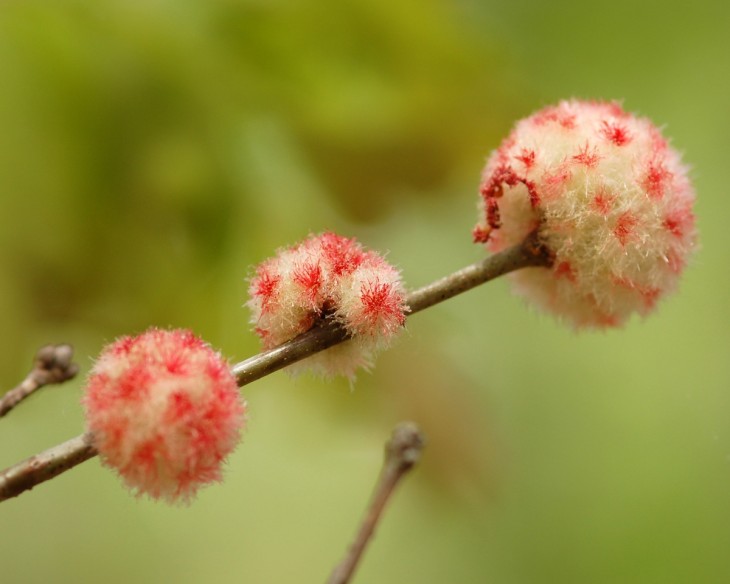
One of the common setups in science fiction is that of an extraterrestrial life-form laying eggs in people who serve as involuntary hosts. Eventually, alien babies burst forth to continue the interplanetary takeover. Amazingly, this creepy scenario resembles things that really happen in the natural world.
Some of the best examples are found on oak trees, which often appear to produce a crop of misshapen fruit – odd swellings on stems and leaves. These are oak galls: tumorlike growths caused mostly by small wasps. Some are spherical, others look like woolly pompoms, and one type even resembles a tiny peach. The word gall traces back to the Latin galla, meaning “oak apple.” Historically, these odd “fruits” have been plucked from oak trees and used to make items ranging from inks and dyes to medicines.
Oak galls make up about 80 percent of the roughly 700 different kinds of plant galls formed by insects in the Nearctic region, which includes the United States and most of Canada and Mexico. During springtime, adult insects lay eggs in the tissues of leaves or twigs and at the same time inject substances that induce the surrounding plant tissue to grow in a particular manner and at an accelerated pace. Galls may form in twigs, leaves, shoots, seeds, and fruit. Each gall takes on the exaggerated character of its host cells. The hard-coated oak bullet gall, for instance, forms from stiff twig tissue, while the soft, fuzzy woolly oak gall results from the rampant growth of the tiny hairs on leaves.
Gall tissues protect and feed the insect larvae that develop inside. As the larvae eat and grow, they exude substances in their saliva, similar to those of the adults, that mimic the plant’s growth hormones and cause the gall to increase in size. Because most gall tissue forms in the plant’s phloem, which carries sugars and other carbohydrates from the leaves to the rest of the plant, galls contain more nutrients than the unaltered, surrounding native plant tissue.
Most galls, especially leaf galls, are merely cosmetic and harmless to the tree, unless they form in great numbers. These galls are an example of commensalism: a symbiotic relationship in which one species benefits but doesn’t harm the other. Galls that form on twigs and branches, however, can hurt the tree by impeding the flow of sap. For example, the gouty oak gall, formed by a chemical stimulant from a tiny wasp, Callirhytis quercuspunctata, frequently infects the twigs of red, scarlet, black, and pin oak. These woody galls disfigure the twigs as they complete their 2-year life cycle.
The gall wasp Callirhytis quercuscornigera (syn. Callirhytis cornigera) causes the horned oak gall to form on the twigs of black oak, pin oak, and scrub oak in the Northeast. Small hornlike spikes grow out from the edge of the woody gall tissue. The two generations of this gall wasp alternate between producing large, conspicuous woody galls on twigs and small, soft galls on leaf tissue. Wasps of both sexes emerge from the leaf galls and reproduce. The females lay eggs in the cambium on twigs and inject chemicals that cause the large, hard, horny galls to form. These galls produce only females, which reproduce asexually.
Another parasitic wasp, Amphibolips confluenta, causes the spongy oak apple gall on trees in the red oak group. Females lay their eggs in leaf buds in early spring. Newly formed galls are green and soft, with a white fibrous mass inside. These golf ball–size swellings mature into a sphere with a crisp, brown, shell-like covering that surrounds an interior of delicate threads radiating out from the center. The larva lives in a small, woody cap¬sule in the heart of the gall.
While not as common, my favorite is the wool sower gall, caused by the tiny wasp Callirhytis seminator. The galls are round with white tufts and appear like oak-borne cotton balls. The wool sower gall wasp lays its eggs in the twigs of white oaks in springtime. The mature gall has reddish spots that look like cotton seeds, in which the larvae can be found.
The gall insects that hijack a tree’s growth process in order to reproduce will often, in turn, become a food source for other wildlife. Woodpeckers, chickadees, and other birds peck holes into hard gall tissues and consume the hapless gall insects. Certain parasitic wasps lay their eggs in preexisting galls, and then the parasite’s larvae eat the gall-maker’s larvae. It is like an alien invasion twice-over.

